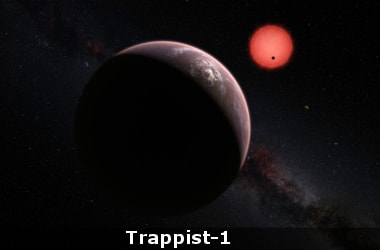
For the first time, astronomers have discovered seven Earth-size planets orbiting a single nearby star - and these new worlds could hold life.
This cluster of planets is less than 40 light-years away in the constellation Aquarius, according to NASA and the Belgian-led research team who announced the discovery Wednesday.
The planets circle tightly around a dim dwarf star called Trappist-1, barely the size of Jupiter.
Three are in the so-called habitable zone, the area around a star where water and, possibly life, might exist.
Scientists said they need to study the atmospheres before determining whether these rocky, terrestrial planets could support some sort of life.
But it already shows just how many Earth-size planets could be out there - especially in a star ripe for extraterrestrial life.
The more planets like this, the greater the potential of finding one that's truly habitable. Until now, only two or three Earth-size planets had been spotted around a star.
The potential for more Earth-size planets in the Milky Way galaxy is mind-boggling.
The discovery gives us a hint that finding a second Earth is not just a matter of if, but when.
University of Liege's Michael Gillon and his team reported finding three planets around Trappist-1. Now the count is up to seven, and scientists said there could be more.
This crowded yet compact solar system - 235 trillion miles away - is reminiscent of Jupiter and its Galilean moons, according to the researchers.
Altogether, astronomers have confirmed close to 3,600 planets outside our solar system since the 1990s, but barely four dozen are in the potential habitable zone of their stars.
Of those, just 18 are approximately the size of Earth.
Both ground and space telescopes were used to identify and track the seven Trappist-1 planets, which they label simply by lowercase letters, "b" through "h."
As is typical in these cases, the letter "A" - in upper case - is reserved for the star.
Planets cast shadows on their star as they pass in front of it; that's how the scientists spotted them.
Tiny, cold stars like Trappist-1 were long shunned by exoplanet-hunters (exoplanets are those outside our solar system).
But the astronomers decided to seek them out, building a telescope in Chile to observe 60 of the closest ultracool dwarf stars.
Their Trappist telescope lent its name to this star.
While faint, the Trappist-1 star is close by cosmic standards, allowing astronomers to study the atmospheres of its seven temperate planets.
All seven look to be solid like Earth - mostly rocky and possibly icy, too.
They all appear to be tidally locked, which means the same side continually faces the star, just like the same side of our moon always faces us.
Life could still exist at these places, the researchers explained.
Chemical analyses should indicate life with perhaps 99 percent confidence.